On the Road with Fred and Barb - Newsletter #21
Aug. 6-11 Fairbanks to Dawson City, Yukon
Aug. 6-7 Fairbanks to Birch Lake
The rain has finally stopped and we have had some beautiful
summer weather. Before leaving Fairbanks, we drove out to Fort Knox
Gold Mine. 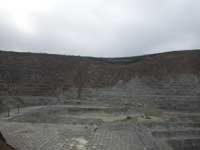 This
is the largest operating gold mine in Alaska and their tour was extremely
interesting. Unlike the Eldorado Gold Mine which does placer mining
by panning for the gold in stream beds, this mine blasts into the bedrock,
then hauls out the chunks of rocks and
This
is the largest operating gold mine in Alaska and their tour was extremely
interesting. Unlike the Eldorado Gold Mine which does placer mining
by panning for the gold in stream beds, this mine blasts into the bedrock,
then hauls out the chunks of rocks and 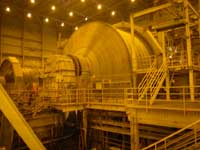 goes
thru various extraction processes to obtain the gold. The only part
of the operation that was off limits to the tour was the smelter where
they melt down the gold and pour it into bars. Darn, I had hoped to
bring home a souvenir!
goes
thru various extraction processes to obtain the gold. The only part
of the operation that was off limits to the tour was the smelter where
they melt down the gold and pour it into bars. Darn, I had hoped to
bring home a souvenir!
After the tour, we headed for Birch Lake, stopping on
the way at North Pole. What a disappointment. It is nothing more than
a large, expensive gift shop with a Santa who was more interested in
reading his book than hearing the wish lists of his visitors. Thanks
to Suzanne and Bob, we were able to camp with them at the military campground
at Birch Lake. Fred assembled the boat and tried a little lake fishing.
Had a few bites and caught one small trout. Still great fun for him.
Meanwhile, the women found some wild raspberries along the road and
picked enough for some raspberry shortcake dessert that night.
Aug. 7-8 Birch Lake to Dawson City
From Birch Lake we headed down to Tok for the night. Then
headed to Dawson City over the much feared Top of the World highway.
We had all heard many horror stories of a narrow, winding, slippery,
washboard road, over the top of a mountain with steep cliffs on each
side. Motorhomes toppling over the side, etc. Maybe it was the time
of year, maybe the weather. In any case, it wasn't half as bad as expected.
The first part of the road from Tok to Chicken was paved except for
the last couple of miles. Chicken is a very small town (15 people in
the winter) that was made famous in the book Tisha about a young school
teacher who came there to teach. Originally the town was named Ptarmigan
but most people couldn't spell it so it was renamed Chicken. There are
several historic buildings to see but the real reason most people stop
is for the cinnamon buns at the café! Yummy.
After Chicken the road is about 30 miles of gravel to
the Yukon border on the Taylor Highway. This was probably the worst
part of the trip as the road was narrower than usual and there were
many hairpin turns. Couldn't go too fast. Fortunately, there were very
few vehicles coming the other way so didn't have to hug the edge. We
learned that when tour buses drive this section they are led by a pilot
car to warn of any oncoming traffic or bad road sections.
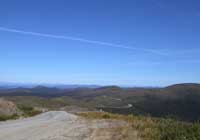 Once
at the border, the actual Top of the Road highway begins, so called
because it winds thru the mountains above the tree line. But the road
is a full 2 lanes, seal coated with some gravel sections. Not bad at
all. The road ends at the Yukon River and you have to get on a small
ferry to cross into Dawson City.
Once
at the border, the actual Top of the Road highway begins, so called
because it winds thru the mountains above the tree line. But the road
is a full 2 lanes, seal coated with some gravel sections. Not bad at
all. The road ends at the Yukon River and you have to get on a small
ferry to cross into Dawson City.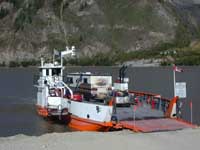 The ferry is free but can only take a couple large RV's at a time. It
takes about 10 minutes to cross so the wait can be long. We were lucky
and only waited about 90 minutes and then all three of us got on the
same trip.
The ferry is free but can only take a couple large RV's at a time. It
takes about 10 minutes to cross so the wait can be long. We were lucky
and only waited about 90 minutes and then all three of us got on the
same trip.
August 8-11 Dawson City
Dawson City was the first capital of the Yukon and site
of the famous gold rush of 1898. It's a really cute town with dirt streets,
boardwalk sidewalks and many historic buildings from that era. Parcs
Canada has done a great job of restoring many of the buildings and others
have been left just as they are. 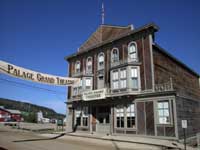 We
took a walking tour with a guide from the Visitor Center and heard lots
of interesting stories about life during the gold rush. Hard to believe
that over 30,000 people filled the streets, living in tents and seeking
their fortunes either in the mine fields or by "mining the miners".
Now the population is about 1800 full timers. We attended the Gaslight
Follies in the restored Palace Grand Theater. The theater was worth
seeing but we saw better shows in Whitehorse and Beaver Creek. We tried
our hand at some Blackjack at Diamond Tooth Gerties Saloon but didn't
fare any better than we usually do in Vegas (which is why we seldom
gamble in our home town.) As in olden days, the casino is also home
to a floor show featuring dance-hall girls and singers. Quite entertaining,
especially since Steve was chosen to embarrass himself on stage along
with 3 other guys trying to follow the ladies in a dance routine.
We
took a walking tour with a guide from the Visitor Center and heard lots
of interesting stories about life during the gold rush. Hard to believe
that over 30,000 people filled the streets, living in tents and seeking
their fortunes either in the mine fields or by "mining the miners".
Now the population is about 1800 full timers. We attended the Gaslight
Follies in the restored Palace Grand Theater. The theater was worth
seeing but we saw better shows in Whitehorse and Beaver Creek. We tried
our hand at some Blackjack at Diamond Tooth Gerties Saloon but didn't
fare any better than we usually do in Vegas (which is why we seldom
gamble in our home town.) As in olden days, the casino is also home
to a floor show featuring dance-hall girls and singers. Quite entertaining,
especially since Steve was chosen to embarrass himself on stage along
with 3 other guys trying to follow the ladies in a dance routine.
Dawson City was also home to two famous authors: Jack
London and Robert Service. 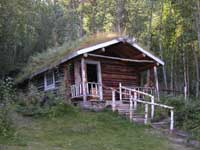 We
visited their cabins and listened to some entertaining Parcs Canada
guides tell stories about their lives and works. Jack London actually
came to Dawson City during the gold rush and tried his hand at mining.
Two of his most famous stories are Call of the Wild and White Fang.
Robert Service was primarily a poet and we have heard renditions of
two of his most famous poems at several of the shows we saw. The Cremation
of Sam McGee and the Shooting of Dan McGrew were performed with great
flare and humor. It was fun learning more about these very colorful
characters and I intend to look for more of their works at the library
when I get home.
We
visited their cabins and listened to some entertaining Parcs Canada
guides tell stories about their lives and works. Jack London actually
came to Dawson City during the gold rush and tried his hand at mining.
Two of his most famous stories are Call of the Wild and White Fang.
Robert Service was primarily a poet and we have heard renditions of
two of his most famous poems at several of the shows we saw. The Cremation
of Sam McGee and the Shooting of Dan McGrew were performed with great
flare and humor. It was fun learning more about these very colorful
characters and I intend to look for more of their works at the library
when I get home.
We drove along Bonanza Creek out to Discovery Claim, site
of the first gold claim in the Klondike. The gold rush only lasted a
couple years and then there was a mass exodus either home or onto the
next gold find in Nome. The "easy" gold in the river banks
was depleted but there was still gold below the surface. Large mining companies set up operation using huge dredges to dig beneath
the permafrost layers. We were able to tour Dredge #4 which is the largest
wooden hull, bucket-line dredge in the North America. It is 2/3 the
size of a football field and 8 stories high.. It continued to operate
until 1960 when they had dredged the entire Klondike valley. There is
still gold in them thar hills as witnessed by some active placer mining
being done by individuals. Certainly not in the quantities of yore but
enough to keep them trying.
Large mining companies set up operation using huge dredges to dig beneath
the permafrost layers. We were able to tour Dredge #4 which is the largest
wooden hull, bucket-line dredge in the North America. It is 2/3 the
size of a football field and 8 stories high.. It continued to operate
until 1960 when they had dredged the entire Klondike valley. There is
still gold in them thar hills as witnessed by some active placer mining
being done by individuals. Certainly not in the quantities of yore but
enough to keep them trying. 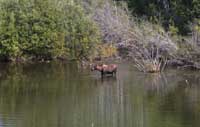 On
the way back to town we saw a moose in one of the ponds along the road.
On
the way back to town we saw a moose in one of the ponds along the road.
On our last day in Dawson City we decided to take a boat
ride 100 miles downstream (north) on the Yukon River to the small town
of Eagle, Alaska, population 150. This used to be the supply and transportation
center for miners and is preserved pretty much as it was in 1899. You
can drive to it on a gravel road off the Top of the World Highway but
this was a much nicer trip. The boat was very plush and comfortable
for the 4 hour trip to Eagle. Along the way we saw some historic gold
rush towns, Athabascan fishing villages and fishwheels, two black bears
and 3 Dahl Sheep. And they served a delicious lunch on the way to Eagle
and a great roast beef dinner on the way back (thank goodness not another
salmon bake!). Very enjoyable. Once in Eagle, we joined a Holland America
tour of the town. There's not much to it but what there is was very
interesting. In the early 1900's Fort Egbert was established as an Army
post initially to provide law and order and later to establish a communication
link with Skagway. The buildings that remain on the base are now a museum
that contains interesting artifacts and old photos from that time.
We have really enjoyed our stay in Dawson City but it's
time to move on. Tomorrow we head down to Whitehorse to reprovision,
do laundry and prepare for the final stage of our journey.

